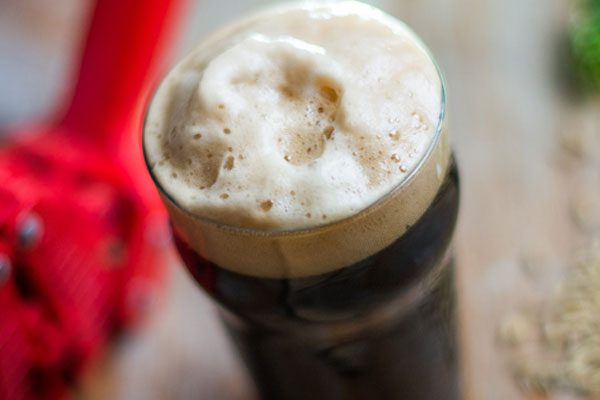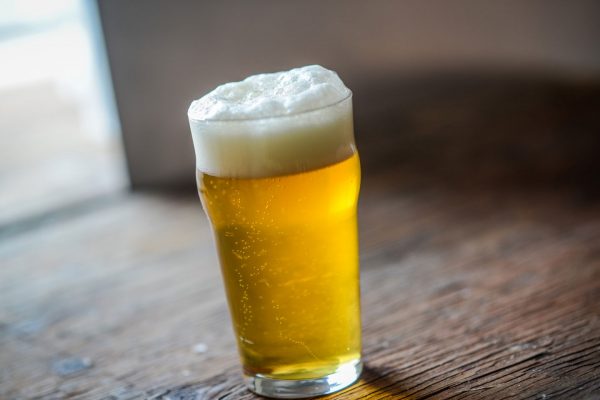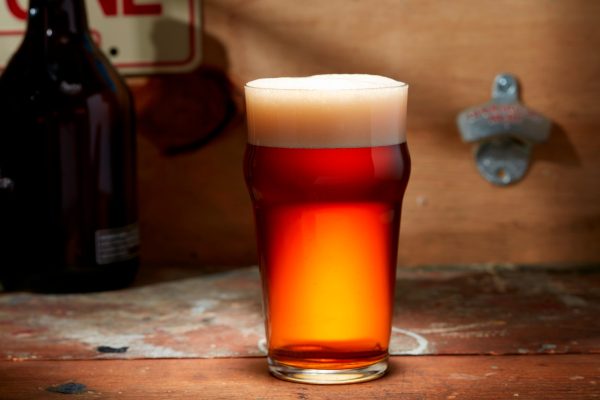
The following beer recipe is featured in the September/October 2018 issue of Zymurgy magazine. Access this issue along with the archives with Zymurgy Online!
Learn about Charlie Papazian's endeavor in brewing this recipe with hops grown at the Smithsonian Museum in Washington, D.C.
by Charlie Papazian
After 48 years of brewing, I still enjoy explorations and recreations with homebrewing. I often tell a story about the beers of the first Great American Beer Festival in 1982, which featured 22 breweries pouring 40 beers for 750 attendees. The “microbreweries” that attended that very first year were Boulder Brewing, Sierra Nevada Brewing, River City Brewing, and Anchor Brewing.
The two beers that seem to be the most memorable were brewed by the then Falstaff Brewing Company: Ballantine India Pale Ale and Narragansett Porter. Both were distinguished by brilliant Cascade dry hopping. Both had a perfect foundation of malt character that elevated what I would call “old-school” Cascade hop flavor and aroma.
For those of you who weren’t around in those early days of Cascade hop cultivation, the Cascade hop of today is very different in character than the original cultivars we welcomed as Cascade hops in the early 1980s. A bright conflagration of citrus and pine is one way I recall experiencing it. My homegrown hops cultivated from those original cuttings still maintain those old-school characters.
The interesting thing about the Narragansett Porter is that it was once a regional brand of New England. The brewery faltered and the brand was bought by Falstaff and briefly resurrected for regionally reminiscent beer drinkers. But the version of Narragansett Porter presented at the 1982 Great American Beer Festival was different than the traditional brew of previous brewers and years.
I reviewed the 1982 Great American Beer Festival program (which I still have) and discovered some interesting information about that 1982 beer. The beer that was originally going to be sent and presented at the Great American Beer Festival was something called Ballantine Porter, and that’s what they sent us program information for. When the beers arrived, we discovered that the brewery had changed the name to Narragansett Porter and festgoers were the beneficiaries. It was a dark, medium-bodied porter with a balanced roasted, toasted dark malt flavor. The lightness of corn and a medium malt body accented the flavor and aroma experience of dry-hopped Cascade perfectly.
America’s First Dry-Hopped Beer
According to the program, which was the information given to us by the brewery, “This dark brew uses malted barley, a small amount of corn grits, top fermenting yeast and a blend of Cascade and Bullion hops. Ballantine [actually presented as Narragansett] Porter is dry hopped in storage during transfer from primary to secondary. CO2 is used to reinvigorate the hops later. … The peak for this brew is around 45 days. The alcohol content is over 6% by volume.”
It struck me that this may have been the first modern-day American-brewed beer that was dry hopped. The few existing microbrewers such as Sierra Nevada, Boulder Beer, River City, and Anchor Brewing were more likely late hopping during the brewing stage. I don’t recall that dry hopping in the fermentation/aging tanks had made its way into the process with American microbrewers yet.
I vividly recall that ʼGansett was delicious, and it has become the kind of beer I really enjoy these days. I wanted to recreate it, so I formulated Flubadub ‘Gansett Porter to replicate what I experienced in 1982. It was after I had formulated my recipe that I came across the above description, and to my delight, my recollection jived with the brewery’s description with one exception. My beer is a bit lower in alcohol content, which is where I am at these days.
Bullion hops are very difficult to get, so I substituted German Hallertauer. Their low bitterness and earthy flavors are easy to navigate. You’ll notice I add a touch of homegrown wild Colorado hops. These hops have a sulfur-like onion character and hardly any bitterness value; their IBU contribution to this recipe is only about 3 BUs. My feeling is that a blend of wild hops and Hallertauer can somewhat replicate Bullion’s character.
So, let’s cut the shuck and jive and get on with the recipe.
Charlie Papazian is founder of the American Homebrewers Association and the author of The Complete Joy of Homebrewing.
The following beer recipe is featured in the September/October 2018 issue of Zymurgy magazine. Access this issue along with the archives with Zymurgy Online!
Learn about Charlie Papazian's endeavor in brewing this recipe with hops grown at the Smithsonian Museum in Washington, D.C.
by Charlie Papazian
After 48 years of brewing, I still enjoy explorations and recreations with homebrewing. I often tell a story about the beers of the first Great American Beer Festival in 1982, which featured 22 breweries pouring 40 beers for 750 attendees. The “microbreweries” that attended that very first year were Boulder Brewing, Sierra Nevada Brewing, River City Brewing, and Anchor Brewing.
The two beers that seem to be the most memorable were brewed by the then Falstaff Brewing Company: Ballantine India Pale Ale and Narragansett Porter. Both were distinguished by brilliant Cascade dry hopping. Both had a perfect foundation of malt character that elevated what I would call “old-school” Cascade hop flavor and aroma.
For those of you who weren’t around in those early days of Cascade hop cultivation, the Cascade hop of today is very different in character than the original cultivars we welcomed as Cascade hops in the early 1980s. A bright conflagration of citrus and pine is one way I recall experiencing it. My homegrown hops cultivated from those original cuttings still maintain those old-school characters.
The interesting thing about the Narragansett Porter is that it was once a regional brand of New England. The brewery faltered and the brand was bought by Falstaff and briefly resurrected for regionally reminiscent beer drinkers. But the version of Narragansett Porter presented at the 1982 Great American Beer Festival was different than the traditional brew of previous brewers and years.
I reviewed the 1982 Great American Beer Festival program (which I still have) and discovered some interesting information about that 1982 beer. The beer that was originally going to be sent and presented at the Great American Beer Festival was something called Ballantine Porter, and that’s what they sent us program information for. When the beers arrived, we discovered that the brewery had changed the name to Narragansett Porter and festgoers were the beneficiaries. It was a dark, medium-bodied porter with a balanced roasted, toasted dark malt flavor. The lightness of corn and a medium malt body accented the flavor and aroma experience of dry-hopped Cascade perfectly.
America’s First Dry-Hopped Beer
According to the program, which was the information given to us by the brewery, “This dark brew uses malted barley, a small amount of corn grits, top fermenting yeast and a blend of Cascade and Bullion hops. Ballantine [actually presented as Narragansett] Porter is dry hopped in storage during transfer from primary to secondary. CO2 is used to reinvigorate the hops later. … The peak for this brew is around 45 days. The alcohol content is over 6% by volume.”
It struck me that this may have been the first modern-day American-brewed beer that was dry hopped. The few existing microbrewers such as Sierra Nevada, Boulder Beer, River City, and Anchor Brewing were more likely late hopping during the brewing stage. I don’t recall that dry hopping in the fermentation/aging tanks had made its way into the process with American microbrewers yet.
I vividly recall that ʼGansett was delicious, and it has become the kind of beer I really enjoy these days. I wanted to recreate it, so I formulated Flubadub ‘Gansett Porter to replicate what I experienced in 1982. It was after I had formulated my recipe that I came across the above description, and to my delight, my recollection jived with the brewery’s description with one exception. My beer is a bit lower in alcohol content, which is where I am at these days.
Bullion hops are very difficult to get, so I substituted German Hallertauer. Their low bitterness and earthy flavors are easy to navigate. You’ll notice I add a touch of homegrown wild Colorado hops. These hops have a sulfur-like onion character and hardly any bitterness value; their IBU contribution to this recipe is only about 3 BUs. My feeling is that a blend of wild hops and Hallertauer can somewhat replicate Bullion’s character.
So, let’s cut the shuck and jive and get on with the recipe.
Charlie Papazian is founder of the American Homebrewers Association and the author of The Complete Joy of Homebrewing.
Ingredients:
- MALTS AND ADJUNCTS
- 8 lb. (3.6 kg) Pilsner malt, plus 1 cup (250 mL) for the cereal mash
- 1 lb. (454 g) flaked corn
- 8 oz. (227 g) aromatic malt
- 4 oz. (113 g) black (patent) malt
- 4 oz. (113 g) black debittered malt
- HOPS
- 0.75 oz. (21 g) German Hallertauer, 4.5% a.a. @ 60 min (3–4 HBU/95 MBU)
- 2.5 oz. (70 g) Wild hops, 1% a.a. @ 5 min (2–3 HBU/70 MBU)
- 1 oz. (28 g) homegrown Cascade, 5% a.a. @ 0 min (5 HBU/140 MBU)
- 1.25 oz. (35 g) homegrown hops, blended into a powder, dry hop
- YEAST
- German or Bavarian type lager yeast. Yes, lager yeast. I use my own 35-year old-yeast, which is sold by White Labs as WLP862 Cry Havoc.
- ADDITIONAL ITEMS
- 1/4 tsp. (1 g) powdered Irish moss
- 3/4 cup (175 mL) corn sugar for priming bottles or 0.33 cups (80 mL) for kegging
Specifications:
Yield: 5.5 gallons (21 L)
Original Gravity: 1.048 (12 B)
Final Gravity: 1.012 (3 B)
ABV: 5%
IBU: 24
SRM: 24
Efficiency: 76%
Directions:
A step infusion mash and separate cereal mash are employed to mash the grains. Add 6 qt. (4.3 L) of cold water to 1 cup (250 mL) crushed Pilsner malt and 1 pound (454 g) of flaked corn and bring to a boil. Meanwhile, add 9 qt. (8.6 L) of 140° F (60°° C) water to the remaining crushed grain, stir, stabilize, and hold the temperature at 132° F (53° C) for 30 minutes. After half an hour, add the boiling corn and Pilsner malt to the main mash. Add heat if needed to bring mash temperature up to 155° F (68° C) and hold for about 30 minutes. Then raise temperature to 167° F (75° C), lauter, and sparge with 3.5 gal. (13.5 L) of 170° F (77° C) water. Collect about 5.5 gal. (21 L) of runoff. Add 60-minute hops and bring to a full and vigorous boil. The total boil time will be 60 minutes. When 10 minutes remain add the Irish moss. When 5 minutes remains add the 5-minute hops. After a total wort boil of 60 minutes turn off the heat, add the 0-minute hops, and place the pot (with cover on) in a running cold-water bath for 30 minutes. Continue to chill in the immersion or use other methods to chill your wort. Then strain and sparge the wort into a sanitized fermenter. Bring the total volume to 5.5 gal. (21 L) with additional cold water if necessary. Aerate the wort very well. Pitch the yeast when temperature of wort is about 70° F (21° C). Once visible signs of fermentation are evident, ferment at about 55° F (12.5° C) for about one week or until fermentation shows signs of calm and stopping. Rack from primary to a secondary and add the hop powder for dry hopping. If you have the capability, “lager” the beer at temperatures between 35 and 45° F (1–7° C) for 3–6 weeks. Prime with sugar and bottle or keg when complete.
Partial-Mash Version
Not an all-grain brewer? Access a partial-mash recipe for Flubadub Gansett Porter!







Share Post